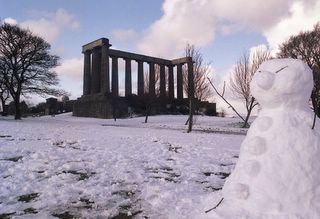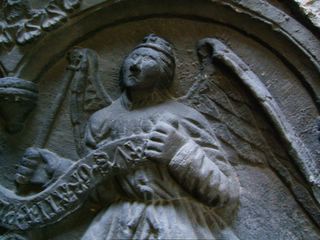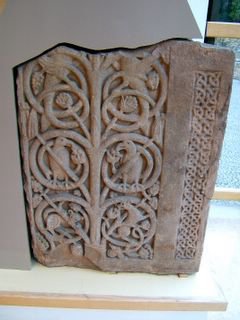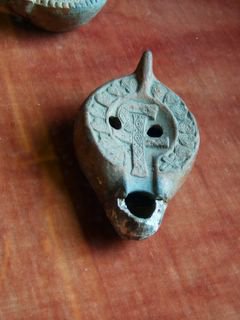Wednesday, November 30, 2005
23:00 -
Readings.
Several nights ago, I was looking in my Jerusalem Bible for some good readings. My eyes stopped on Ecclesiaticus. I read:
In prosperity you cannot always tell a true friend,
but in adversity you cannot mistake an enemy (12,8).
Then I continued and I found out that it even contains self-irony:
The mark of a good heart is a cheerful expression;
inventing proverbs is weary work(13,26/32).
I know what I am going to read in the next couple of months.
I find the post of
Chad interesting. Please have a look at it.
Tuesday, November 29, 2005
22:51 -
Pomegranates - Part 2.

...And here we are, the final result. Everything suddenly becomes much easier.
22:50 -
Pomegranates - Part 1.

I like pomegranates. If, like me some time ago, you are disappointed by having to collect the little arils (I am not sure about the term), grab a chair; I am going to explain how to reduce the time you will need to eat it: I learned it by experience.
Interestingly enough, there is a structure in it. It is not as regular as that of an orange, and it considerably varies. However, with some patience, you will notice that its curvature is not homogeneous. Technically, I would say, there are local maxima. If you score vertically exactly at those points, which are those in which the internal sections meet....
Monday, November 28, 2005
19:33 -
Carlton Hill - Edinburgh

Waiting for this year's snow, a picture taken last winter. The snowman was already there.
19:11 -
Admittedly, this is not one of the best moments of my life. So, the Bible helps, in cases like this: the words for moments like this are written in Jeremiah 20,14-18. Extreme words, espressing his distress directly to the Lord. Now, thinking about it, a film came to my mind: the masterpiece of
Frank Capra. Reel life, but a masterpiece.
Sunday, November 27, 2005
02:47 -
Caserta Palace

Neapolitan crib (Am.Eng.= creche).
02:26 -
Kurt Schwertsik. 'Twilight Music - A Celtic Serenade for Octet' (17'20") - The RNCM New Ensemble conducted by Clark Rundell
Sing to the Lord, my heart, sing to the Lord. May my life spent for your glory be fruitful, one day.
Saturday, November 26, 2005
19:07 -
Edinburgh- Royal Mile

I found another one. It's there mostly for tourists, though. At the moment Edinburgh it's not so sunny. Streets are busy because of people doing shopping for Christmas.
18:10 -
Another test...
Suggested by
Irish And Dangerous. Well, I didn't know I was 79% Lutheran. What does being Lutheran mean?
Your results for Christian Traditions Selector
Percent Rank Item
(100%) 1: Roman Catholic
(79%) 2: Eastern Orthodox
(79%) 3: Lutheran
(77%) 4: Anglican/Episcopal/Church of England
(64%) 5: Presbyterian/Reformed
(49%) 6: Congregational/United Church of Christ
(42%) 7: Baptist (Reformed/Particular/Calvinistic)
(35%) 8: Church of Christ/Campbellite
(33%) 9: Methodist/Wesleyan/Nazarene
(10%) 10: Pentecostal/Charismatic/Assemblies of God
(6%) 11: Baptist (non-Calvinistic)/Plymouth Brethren/Fundamentalist
(6%) 12: Seventh-Day Adventist
(5%) 13: Anabaptist (Mennonite/Quaker etc.)
Original test
here.
11:29 -
Addio illusioni.
From an interesting article on
The Economist:
Social trust, a concept that is admittedly hard to measure, seems unusually low in Italy—one reason, perhaps, why family firms have always played such a big part in the economy. And respect for the rules, and even the law, never high, appears to have fallen further in recent years. Both tax evasion and illegal building, encouraged by repeated amnesties, seem to be on the rise. Organised crime and corruption remain entrenched, especially in the south.
Friday, November 25, 2005

You would not imagine to find one of these in such a remote place.
19:23 -
Don't Forget...
Albertus Minimus is often writing interesting posts on Islam, Christianity and the relationship between the two. And if you spot a saint with earring(s) please tell it to
Zadok.
19:14 -
Annunciation Stone. Detail. Dunfermline Palace

I found this prayer which seems the exact (I mean almost word by word) translation of one of my preferred Italian prayers:
Angel of God,
my guardian dear,
to whom God's love commits me here,
ever this day,
be at my side
to light and guard,
to rule and guide.
18:56 -
As several of you already know...
I have started a
new Blog, it is meant to be thematic and complementary to this one. I have been quite focused on my job, so I did not update it recently. However, I will make a point not to give too much space to the treacherous and greedy pagans with whom I am working and posting in it at least once a week.
Tuesday, November 22, 2005
.... Don't miss the second. The first program was about the legend surrounding the death and facts of the life of
St. Cecilia. The program gave some insight on the story related to her marriage (which, by the way, was more or less worded as in the Catholic Encyclopaedia link), wonderful music, some possible historical insight on her community (was she belonging to a Jewish community?).
The next program will supposedly be about Hymns and Odes composed about her.

Apparently, sculptured head of King Malcom III, husband of St. Margaret and father of King David I of Scotland.
Monday, November 21, 2005

The pier in the nave with its strange zig-zag pattern. Close to it there used to be the original tomb of
St. Margaret .

The face of St. Margaret of Scotland, sculptured on the vaulted storage cellar beneath the lower kitchen.
Sunday, November 20, 2005
13:33 -
So Mass
sang in Latin yesterday. I didn't manage to get the leaflet (my fault). No offence to anyone: I don't see much of a difference from the kind of solemn celebrations we still have in the south of Italy, except the language (on Easter is quite a custom to have several parts of the Mass sang in Latin, though). A big hello to all the friends I met after the Mass. A huge thank to the organisers of the event (I know how difficult organising this sort of events can be). I decided to add a new link to my fellow bloggers menu, I hope nobody gets hurt because of that.
Saturday, November 19, 2005
22:58 -
Annunciation Stone - Detail - Dunfermline Palace

As I read from the description: "This stone used to be above an oriel window on the top floor of the guest house range (later the palace)." The photo is blurred, I apologise, but it was quite cold, the camera stoppped working several times, and I tried to make the best of the light I had.
Wednesday, November 16, 2005
22:57 -
And to Caesar...

Her Majesty at the opening of the Scottish Parliament,
October 2004. Unfortunately I did not have a polarising filter...
22:51 -
Coin of the day

Which I've got yesterday as a change, buying my daily bread.

Through
Il Villaggio Virtuale. In Italy parish priests have started a debate on installing CCTV in Churches. Here the opinion of the Benedictine Angelo Ceriotti, who has a degree in law and theology:
Penso che sia indispensabile valutare bene. Nel caso di una Chiesa che contenga opere artistiche di valore, penso che la presenza di un sistema di sorveglianza (discreto e mirato soltanto all'opera d'arte, non certo ai luoghi in cui si fermano i fedeli) non dovrebbe disturbare nessuno. Cosi' pure come nel caso in cui, in via del tutto eccezionale, sia necessario intervenire a seguito del continuo verificarsi di furti, anche se di piccola entita'. Al di fuori di queste ipotesi, ho parecchie difficolta' ad accettare un sistema fisso, ordinario, generalizzato di videosorveglianza: la pieta' popolare, la fede nell'Assoluto, la voglia di silenzio e di preghiera mal si conciliano con la curiosita', anche se del parroco.
My translation:
I think the subject requires a careful evaluation. If a Church contains precious works of art, a CCTV (dicreet and directed only to the work of art, certainly not to the places in which parishioners pray) would not annoy anyone. Similarly, when, exceptionally, an intervention is needed, when continual thefts happen, even the smallest ones. A part from these hypotheses, it is difficult to me to accept a CCTV: the piety of the faithfuls, the faith in the Absolute, the need for quiet and prayer, are not suitable for the curiosity, not even the curiosity of the parish priest.
Tuesday, November 15, 2005
00:09 -
Abortion and the aliens...
No, I am not going to write something like "Kant and the Platypus", I am not be qualified to do such thing.
Now, I have been thinking about this during the last couple of weeks and looked for some kind of documentation, I could not find much, so, dear reader, you will have to be patient and read my reasoning.
It is quite easy for a Catholic to follow the usual way a Catholic would debate against abortion, that is using theological descendent (from God to the creation) arguments, but what if the debate should be brought to a secular society like ours, more biased towards the 'how' rather than 'why'?
The problem is mainly
legal.
As far as I know Western legislation aknowledges the right to exist to human beings as such. So, clearly, an abortion is possible only if the organism is not recognised as a human being.
I see the point: it's quite easy to assert that an organism that does not look as a human being is not a human being. I see how it is even possible to build a large consent based on such cathegorisation. I mean Turing devised his test on intelligence using a behavioural framework. If it looks intelligent as a human being, then it is intelligent.
But how is that measurable? Yes, you can measure time, but it sounds unconvincing to me that it is time that decides whether an organism is a human being or not. Just give it enough time and you will have human beings even from stones...
And if, after 20 years the organism still does not behaves like a human being, it is not a human being and can be distroyed without any problem.
Well, then here we are: the argument that uses the DNA to define a human being. A human being is an organism (and not an organ), whose cells are built on a human DNA.
It's a clear, simple,
measurable definition. No theological argument is needed, it may even be argued that it's self evident. It even subsumes the way moral cases like genetic engineering and in vitro fertilisation should be considered.
However, there are several problems, as far as I can see, that this approach discloses.
First, and most important, it is not true that a cell has a DNA from the conception (it was shocking reading it, but there is a measurable grey zone before the DNA appears). Certainly even acknowledging the DNA definition would be a big progress, but I see the need of providing such simple and measurable criterion to recognise a human organism.
Second, and quite relevant from the theological point of view: accepting the DNA definition means that God is ready to put a soul inside an organism with a human DNA. So read, honestly, seems really strange. Theoretically we could create in laboratory a cell and a human DNA from inorganic material (it's just theoretical and hypothetical, right?). So
that would be a human being with a soul. Very strange...
Furthermore, suppose that one day we will meet other non human civilisations (Again, it's just a theoretical hypothesis, right?), organisms that are not based on DNA, do we want to rule out the possibility that they could love God as we do?
Puzzling. I am sure somebody, in the Catholicism, already wrote about all these issues (in a synthetic way), but who? Any interesting readings about the topic (I mean one single exhaustive book)?
Sunday, November 13, 2005

There is not much more than this cairn in Duns to remember John Duns Scotus, and as I read his birth place is matter of
debate .
21:06 -

Thank God for the superabundance of Light we had today. Clear, white light. It was marvellous.
Saturday, November 12, 2005

This tree is though to be several centuries old. It is recorded in the Kirk Session minutes in 1630. The trunk measures 3.64m (12 feet).The close building is adjacent to the Scottish episcopal church of St. Cuthbert, in Colinton, Edinburgh.

It is know that Robert Louis Stevenson, the famous writer, played under this tree.
A Yew, which is one of the glories of the village. Under the circuit of its wide, black branches, it was always dark and cool, and there was a green scurf over all the trunk among which glistened the round, bright drops of resin
--- from "To Minnie" in "a Child's garden of verses" 1885.
Thursday, November 10, 2005
21:16 -
Internet and the Italian Church.
In the past days I have been looking for some Italian blog with English translation, so to provide a means to contact the Italian Catholic world to those of you, dear English readers, who would like to, but haven't had any opportunity yet.
As a result I realised that there aren't many, and finding them would be quite difficult (Why is that sounding like a sort of mission to my ears ...?).
Italian Catholicism does not move over the Internet, rather mainly through interpersonal relationships, as my experience taught me.
There is an Italian
list of catholic sites, but, as I was saying, it is in Italian.
Barbara Fiorentini, who works at the library of University of Sacro Cuore, in Piacenza, provides, in her
blogs, interesting news about the Italian Catholic panorama.
I'll keep you informed (in my poor English), if you are interested in the topic.
21:15 -
Jedburgh Abbey

This shrine fragment is dated to the early eight century. It is quite important because it bears roman (birds and leaves) and celtic symbols. It is considered one of the early eaxmple or christian art in Scotland.
21:10 -
Mark 7
Given that usual Bible meeting at the Dominicans will be suspended until the beginning of the next year (and maybe longer) for chronic absence of interested people (what's happening to these new generations, not even taking care of making up an excuse...), I share with you, dear readers, some reflections on the topic.
First of all a
link that I use for my statistical research on the Bible. It's a site in development. It is possible to find the scriptures in their original language (Namely : "jtauber's GNT v. 5.07, CATSS' LXX, Tanakh, Deuterocanonical"). I know there are tools that allow a more extensive search over the classical Greek literature, but they are not for free...
The personal story of Zack Hubert is quite interesting, I would suggest to have a look at it, if you have some time.
The site is interesting for the statistical links and histograms that provides on every single word of the text. It is not possible to write queries, but for a basic level is more than enough.
Some word worth being pondered (Mark7,21-22): "πορνεῖαι κλοπαί φόνοι (22) μοιχεῖαι πλεονεξίαι πονηρίαι δόλος ἀσέλγεια ὀφθαλμὸς πονηρός βλασφημία ὑπερηφανία ἀφροσύνη" the twelve things that come out of a human heart, and that make men unclean. Here the language is typically related to the Prophets. The list could have been the "draft version" of the seven deadly sins. Jeremiah used almost all of them.
Another interesting word used would be (Mark 7,28) κυνάρια (little dog). It's strange to me to imagine Jesus using it. What is the use of it in other sources?
Tuesday, November 08, 2005
21:02 -
Dirleton Castle gardens

World's longest herbaceous border. According to the Guinness Book of records in 1999. But don't ask me if it is still true....
Monday, November 07, 2005
22:10 -
Sob!
 | You scored as Engineer. Military Engineer. Your job is usually overlooked, but without you nothing gets done. While you sometimes annoyed at this, and you know the only time people come to you is when there's something wrong. You understand that you are the heart and soul of any organization with honesty and nice work ethic to boot.
"I need more Duct Tape!!!"
Engineer | | 94% | Medic | | 75% | Civilian | | 75% | Combat Infantry | | 75% | Support Gunner | | 63% | Special Ops | | 56% | Artillery | | 38% | Officer | | 38% |
Which soldier type are you?
created with QuizFarm.com |
Sunday, November 06, 2005
17:24 -
Archeological findings in Megiddo.
According to
Reuters:
"This is, in Israel for sure, the earliest church," archaeologist Yotam Tepper, who heads the excavation, told reporters.
According to
Haaretz:
One of the most dramatic finds suggests that, instead of an altar, a simple table stood in the center of the church, at which a sacred meal was held to commemorate the Last Supper.
According to
Washington Post Joe Zias, an anthropologist and a former curator with the Israeli Antiquities Authorities, said the discovery was significant but unlikely to be the world's oldest church. He said Christianity was outlawed until the time of Emperor Constantine in the fourth century, and there were no churches before then.
Images from
Repubblica
Saturday, November 05, 2005
Multilayered work of art. It could be read under several perspectives. Undoubtably, one of them would identify the witch with the Catholic Church, in a ivory tower, self indulging in a sort of chapel decorated with beautiful images of saints (that may risk to hurt some sensibilities). I would not be surprised to hear Gilliam saying that. However, honestly, I don't think the film is anti-catholic. It looks to me like he meant to show a contrast between rationality (the French general would represent all the lucid and merciless values of the Enlightenment) and its opposite, proving that ratio is not enough to deal with the inner realities of human beings. Then this would be equivalent to criticise the Church, and probably any religious movement, when they fail to fullfill their proper mission of giving meaning to this gap. I may be overinterpreting, though.
Another possibility, which may be superimposed to the previous, is that he tries to show how women deal with evil. The unavoidable comparison is with Lord of the Rings, in which the evil deal with the reality of the world mainly through men.
Certainly the film is about abuses,
metamorphosis (after all growing up is a big change), finding the right direction in a changing environment.
It's dark, I don't think this is a film for children. It is rich in Christian iconography.
Millais Ophelia is used as the base for an entire scene.
Some note on style: Gilliam decided to give a lot of freedom to the actors. I don't know whether this is only an experiment or a line that he intends to follow in his future work. At the moment the technique is not refined and sometimes scenes look like episodes, stopping the plot for some while. But it's only my opinion...
Wednesday, November 02, 2005

It is not lit, but I hope you will stop for some moment and pray for the Holy Souls.
Tuesday, November 01, 2005
22:32 -
All saints. Trento- Cathedral.

Front Rose Window. End of XIII Century. I don't think this is supposed to be a wheel of fortune: there is already one on the side of the Cathedral. It is cryptic for me: I see the 12 petals in four groups of three at the center, but, then, it is the number four which is developped.
After the first reading of today, I suspect this window was built using an Apocalyptic symbology. At the outside there are the four beasts and possibly
"Victory to our God, who sits on the throne, and to the Lamb" (Rev 7,10) [Jerusalem Bible]
Yet, I cannot work out the 4x4 symbology.























